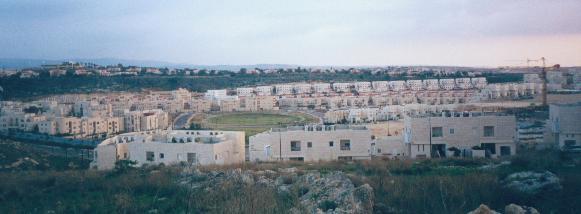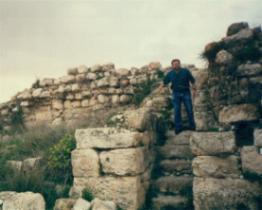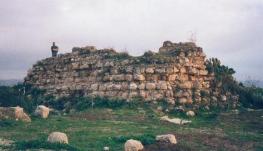
View from the Tetora Hill of the eastern neighbourhoods of Modi'in with the neighbouring town of Re'ut in the background

View from the Tetora Hill of the eastern neighbourhoods of Modi'in with the neighbouring town of
Re'ut in the background
Ancient Modi'in was almost totally destroyed over the centuries both by later civilisations and possibly by an earthquake, but on the edges of modern Modi'in there are various archeological sites which are thought to have been ancient Modi'in.
In general the area is rich in archaeological sites dating as far back as the Chalcolothic period and encompassing the biblical, second Temple (Persian, Greek and Roman), Byzantine, Mamluk, Crusader and Ottoman periods.
More than any other place, Modi'in is associated with Hannukah, the Festival of Lights. Ancient Modi'in was home to the Maccabees or Hasmoneans, the priestly family who led the Jewish rebellion against Greek Selucid rule in the second century BCE.
Hannukah celebrates their victory over the tyrannical Selucid king Antiochus and their liberation of the holy Temple in Jerusalem which Antiochus had defiled in his attempt to subjugate the Jews. Subsequently the Hasmoneans went on to found a dynasty of Judean kings which ruled until the time of Herod in the first century CE.
The exact site of ancient Modi'in is disputed. In the last few years new evidence has been uncovered at a site on the southern edge of Modi'in, Um el Umdan, on the Modi'in-Latrun road. In addition to an ancient synagogue, finds include the remains of a Hasmonean village, complete with the remnants of a street of row houses, a mikvah, a luxurious villa and a market place. Some scholars believe the Um el Umdan synagogue to be the oldest ever discovered. Relics from the Persian, Hasmonean and Roman periods were found, including coins which help archaeologists to date their discoveries.
I visited the site during the original excavations a few years ago and was impressed by the scale of it - although only foundations and ruins were visible it took very little imagination to see that this was a significant size village or small town - the excavations sprawl over a 240 dunam site. Whether this is ancient Modi'in itself, the site was clearly an important regional centre.
Um El Umdan was already known to researchers in the 1860s during the PEF's tour of the region, with some European biblical scholars suggesting it as one of the possible sites for ancient Modi'in. The modern Arabic name, Um el Umdan literally translates as "mother of the pillars", referring to the ruined columns of the ancient synagogue, once a prominent landmark in the region before they were stolen by looters.
Sadly the site is in the way of a major road widening project and it remains unclear how much of it will be saved, aside from the ancient synagogue.
Some say ancient Modi'in is near the Arab village of Midya, near a site many locals identify as the tombs of the Maccabees. Others point to a hill on the edge of the modern town of Modi'in, known as the Tetora hill, where huge rectangular stones dating back to the Hasmonean period have been found at the base of a ruined Crusader watchtower.
Still others say that the name Modi'in, which is in the plural, refers to the region in general, perhaps a collective term for the Hasmoean era villages and homesteads whose ruins have been unearthed throughout the area.
On top of the Tetora Hill on the northeast edge of Modi'in there are the remains of a Crusader watchtower which was built on top of ruins dating from the Hasmonean period. Some scholars believe these Hasmonean-era large carved rectangular stones indicate that Tetora was the site of ancient Modi'in. Site archaeologist Dr Shimon Gibson says that the Hasmonean stones used in the foundations of the tower were taken from the ruins of Hasmonean period buildings in the area and re-used by later inhabitants of the area.
Other finds on the Tetora hill include Greek, Roman and Byzantine era olive and wine presses and burial caves; caves possibly inhabited by Calcholithic people; and assorted artifacts from the Iron Age, the period of the ancient Israelite kings.
 Rectangular Hasmonean era stones |
Other archeaological sites near the modern town of Modi'in have turned up two of the most ancient synagogues ever discovered, both dating to the Hasmonean era, one at Um el Umdan, the other near the town of Kiryat Sefer (Modi'im Illit). Due to a lack of funds these sites have not been properly excavated or developed for visitors, but many in the region dream of them becoming designated archaeological parks open to the public. If funding is not found they will probably just be covered up once more to protect them from the elements.
One of the most famous sites in the region, The tombs of the Hasmoneans, is still something of an unsolved mystery. From the Apocrypha and the works of the Roman era Jewish historian, Josephus, it is known that the tomb was some kind of conical or pyramid shaped building on a hilltop from which the coast was visible. It was described as visible to pilgrims from the port city of Jaffa. There are several places in the Modi'in area from which the sea is visible.
The site of the modern memorial listed on the map as the "Graves of the Maccabbees" is actually not the correct site. Just down the road from there, in the Modi'in forest, are other ancient ruins, believed by many to be the exact site, though it has yet to be properly excavated.
A domed late Ottoman period tomb is believed by some in the region to mark the site of the tomb of Matityahu, the Hasmonean priest who initiated the Jewish revolt against the Selucids. In the late nineteenth century, during the time of the Palestine Exploration Fund's (PEF) study of the region, local Arabs referred to the site as Hirbat el Yehud or by other names indicating a Jewish connection.
Today Jews come from nearby religious communities to pray at the site.More recently the site of Hirbat Sher, adjacent to the Modi'in-Latrun road, has been cited by some as the site of the Maccabean graves. A large selection of Hasmonean era tombs were discovered at the site, including some with ornate decoration and inscriptions. Lack of funding has prevented further study of the site. The municipality together with archaeologists have organised community digs in the area, promoting interest especially amongst the town's younger residents in the preservation and exploration of this region's rich heritage.
Modi'in also had a more peaceful role in the ancient history of the Jewish people. It lies on the rolling, rocky foothills of the Judean Mountains, about halfway between the coastal plain to the west and the mountainous Jerusalem region to the east.
The Mishna mentions Modi'in as a waystation for pilgrims going up to the Temple in Jerusalem for the three major pilgrimage festivals, Pesah (Passover), Shavu'ot (Pentecost) and Sukkot (Tabernacles). The Talmud describes Modi'in as being being 15 Roman miles from Jerusalem's Temple Mount.
Modi'in is referred to as the first place on the road to Jerusalem where pilgrims could purchase earthenware vessels for their Temple offerings because Modi'in's proximity to the holy city meant that the town's potter's were careful to maintain ritual purity, and hence their utensils were suitable for use in the Temple.(Haggiga 3:5)
An archeaological site in Modi'in, the Tetora Hill on the northeast edge of the modern town, has yielded a huge number of water cisterns, as well as several mikvaot (ritual baths) far more than would have been needed by the local populations. The may well have served the pilgrims preparing themselves for a visit to the Temple.
Several mikvaot(Jewish ritual baths) have been found on the Tetora - facilities required for ritual purity, such as that required to enter the Temple complex. Ritual baths are found in all Jewish communities, what is striking about at least one of the mikvaot found on the Tetora is its size. One mikva has two doorways, one for the ritually unclean person to enter, and one for him to exit, having purified himself in the bath. This implies a very "high traffic" mikva which necessitated such an organised one way system to handle the many pilgrims using the site.
The many cisterns on the hill, about 120, far in excess of what the town itself probably needed, were probably there for pilgrims using Modi'in as a reststop. Likewise the large columbaria (dovecotes) may well have been there to feed the huge numbers of pilgrims, or possibly for pilgrims to purchase doves to sacrifice at the Temple.
 Watchtower ruins on the Tetora Hill |
The Hasmonean Maccabees were not the only Jewish rebels from this region though. The Roman empire,just beginning its ascent during the Hannukah story, had become the dominant superpower by the time the Hasmoean dynasty gave way to Herod. The crumbling of the dynasty allowed the Romans to extend their rule over Judea and with Roman rule came a new tyranny. In the years 77-73 AD the Jews rose against Rome, and were brutally crushed, the Romans destroying Jerusalem and its holy Temple, as well as many other Jewish centres.
In 132 AD, centuries after the Hannukah story, the Great Revolt against Roman rule led by Bar Kokhba began in the Modi'in region, the last attempt by the Jews to regain independence until modern times. The revolt began in Haruba, in the Modi'in area, a site close to the village of Gimzo, a modern argricultural community which dates back to biblical times.
Among the leaders of the revolt was Bar Kokhba's uncle, Rabbi Elazar Hamoda'i (Rabbi Elazar of Modi'in), one of the early Talmudic scholars known as the Tanaim. Excavations in the modern town of Modi'in and the surrounding countryside have found tunnels which were used by the Bar Kokhba rebels to hide from the Romans.
| Byzantine era mosaic |
Under and around the Crusader era watchtower on the Tetora there are tunnels and caves which were used by Jewish rebels during the Bar Kokhba revolt. A few years ago local youngsters exploring the tunnels came upon pottery in them along with a coin dating from the time of the revolt. On the coin was the rubbed out portrait of the Roman leader Adrianus, and in his place the Jewish rebels had inscribed a message 'for the redemption of Jerusalem' in ancient Hebrew.
Following the failure of the Bar Kokhba revolt and the destruction of the Jewish community in the area a new, mostly Christian population became established here. At several locations throughout the area Byzantine era ruins have been found, including at moshav Mevo Modi'in some beautiful mosaics and other ruins from what is believed to have been an ancient monastery. Ruins on the Tetora hill include the remains of a Byzantine era farmhouse with a white mosaic floor with an adjacent quarry, as well as a wine press from the same period, also with mosaic decoration.
The fast pace of development in the modern town of Modi'in, and it's northern neighbour Modi'in Illit, has not coexisted easily with those who wish to study and preserve the archaeological heritage of this region, some of the richest in Israel.
While local law requires "rescue digs" to be undertaken before any building work begins, these have often been so rushed and underfunded that they have yielded little chance for conservation, only a brief survey of the site, the removal of any portable relics to the safety of the Antiquities Authorities vaults, and then many such sites have either been filled in or flattened, and then built upon.
During December 2004 an impressive Hasmonean era industrial size olive press was discovered. However it lay in the way of a new development in the rapidly expanding Buchman neighbourhood. Local conservationists led by Dr Ofra Auerbach were in the process of obtaining a court order to protect the site after the Antiquities Authority released it for construciton, but the Housing Ministry pre-empted any possible legal action by demolishing the site on Hannukah eve. For more information see the following article
Shocked by the wanton destruction of such a potentially important site several members of Knesset (Israel's parliament) contacted local activists, and a delegation subsequently appeared before the Knesset environtmental lobby to make the case for changing the laws governing the protection of antiquities.
At the time of writing several of these proposals have reached the committee stage, while increased awareness of the precious archaeological sites in the Modi'in area have meant that several, including the ancient synagogue and a Chalcolithic site adjacent to the now destroyed olive press will be preserved as archaeological parks.
Introduction |
Location |
Historical sites in the Modi'in region|
Modern Modi'in
Population and Employment |
Services and Amenities |
Modi'in's Neighbours |
Recreation Areas
Eating Out |
Modiin area birds
Copyright 2005 by Leiah Elbaum. Text and photographs on this page are by Leiah Elbaum. Last updated 15 May 2005.